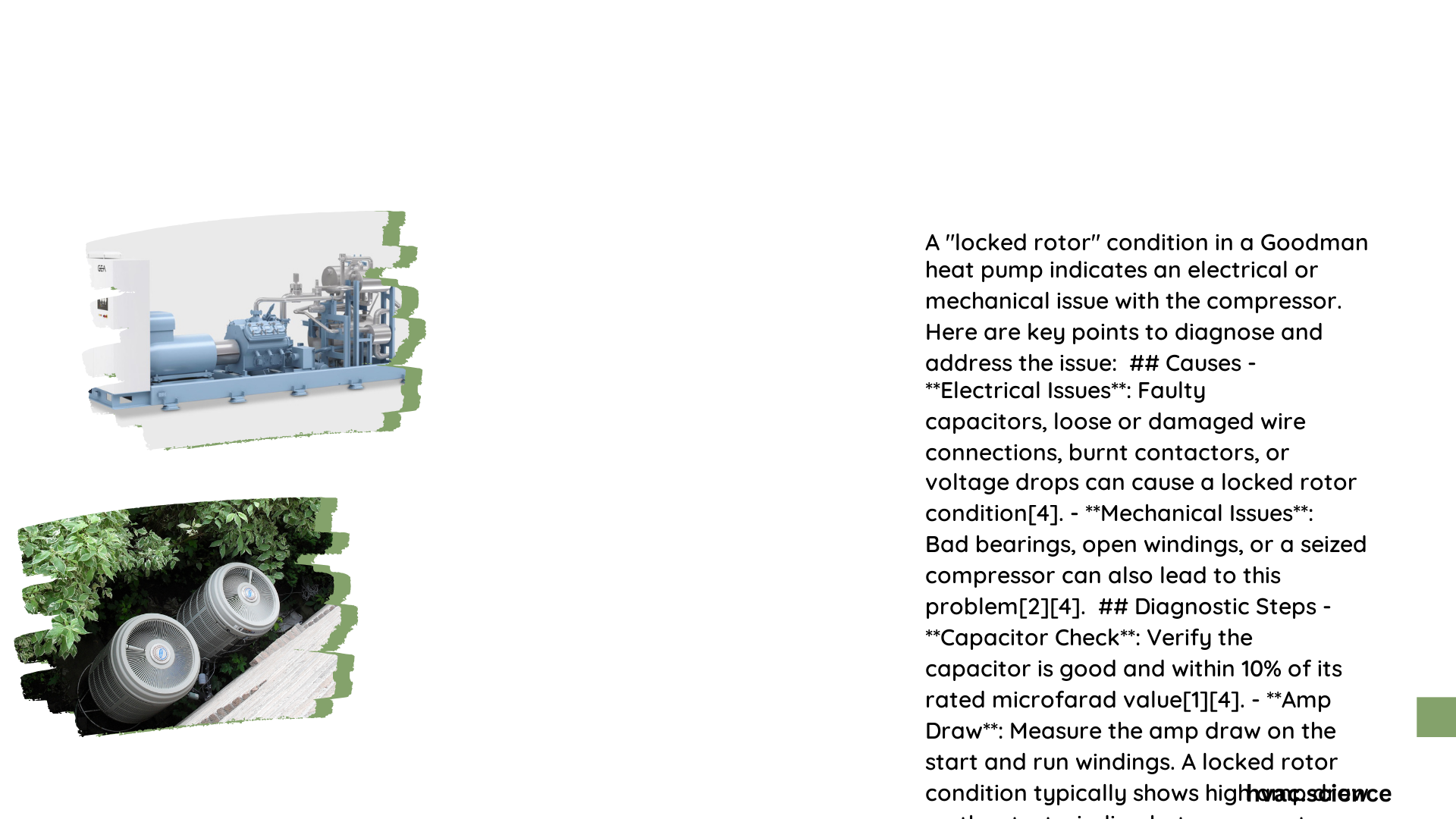A Goodman heat pump locked rotor occurs when the compressor’s motor fails to start or rotate, causing high current draw and system shutdown. This issue can lead to inefficient cooling, tripped circuit breakers, and potential damage to the heat pump. Understanding the symptoms, causes, and troubleshooting steps for a locked rotor condition is crucial for maintaining the performance and longevity of your Goodman heat pump system.
What Are the Symptoms of a Goodman Heat Pump Locked Rotor?
A locked rotor in a Goodman heat pump can manifest through several telltale signs:
- Compressor humming without starting
- Brief compressor operation followed by shutdown
- Frequent circuit breaker trips
- Internal overload protection activation
- Fault codes indicating locked rotor condition
- Inadequate cooling performance
- Continuous fan operation without compressor function
These symptoms often indicate a serious issue that requires immediate attention to prevent further damage to the heat pump system.
What Are the Current Specifications for a Locked Rotor Condition?

Understanding the electrical characteristics of a locked rotor condition is essential for proper diagnosis:
| Specification | Typical Range |
|---|---|
| Locked Rotor Amps (LRA) | 20-40 amps |
| Start Winding Current | 20-40 amps |
| Run Winding Current | Similar to start winding |
Note: Actual values may vary depending on compressor size and incoming voltage.
Exceeding these specifications can lead to:
– Mechanical compressor failure
– Voltage drop issues
– Capacitor malfunction
– Contactor problems
Prolonged high current draw often triggers internal overload protection, causing system shutdown.
How to Troubleshoot a Goodman Heat Pump Locked Rotor?
Follow this step-by-step process to diagnose and troubleshoot a locked rotor condition:
- Gather necessary tools:
- Multimeter
- Screwdriver
- Capacitor tester
-
Wiring diagram for your specific model
-
Check the capacitor:
- Disconnect capacitor wires
- Test capacitor using a capacitor tester
-
Ensure microfarad rating is within ±10% of specification
-
Measure current draw:
- Turn off power at the thermostat
- Manually activate the contactor with a screwdriver
-
Quickly measure current draw on start, run, and common windings
-
Verify voltage:
- Measure voltage at the contactor’s load side
-
Check for significant voltage drops during locked rotor condition
-
Inspect wire connections and contactor:
- Look for loose or damaged connections
- Ensure contactor functions correctly
-
Replace contactor if necessary
-
Assess refrigerant charge:
- Verify proper refrigerant levels
-
Low charge can mimic locked rotor symptoms
-
Check for voltage drop:
- Measure voltage from breaker panel to compressor
-
Ensure drop doesn’t exceed 10%
-
Take ohm readings:
- Measure resistance between R and C terminals on compressor shell
- Check for open windings (compressor must be cool)
What Is the Reset Procedure for a Locked Rotor?
After identifying and addressing the root cause of the locked rotor condition, follow these steps to reset your Goodman heat pump:
- Allow internal overload protection to reset (may take several minutes)
- Verify all settings and connections are correct
- Restart the system carefully
Safety precautions:
– Always disconnect power before performing tests or repairs
– Use appropriate personal protective equipment
– Follow manufacturer guidelines and local codes
What Are Common Causes of a Goodman Heat Pump Locked Rotor?
Several factors can contribute to a locked rotor condition in a Goodman heat pump:
- Mechanical issues:
- Seized compressor bearings
- Broken internal components
-
Liquid refrigerant slugging
-
Electrical problems:
- Faulty start capacitor
- Damaged run capacitor
- Defective contactor
-
Loose or corroded electrical connections
-
System imbalances:
- Improper refrigerant charge
- Restricted refrigerant flow
-
High head pressure
-
Power supply issues:
- Low voltage
- Voltage imbalance
-
Single-phasing (in three-phase systems)
-
Environmental factors:
- Extreme ambient temperatures
- Dirty condenser coils
- Blocked airflow
Understanding these potential causes can help guide your troubleshooting efforts and prevent future occurrences.
How to Prevent Goodman Heat Pump Locked Rotor Issues?
Implementing a proactive maintenance strategy can significantly reduce the risk of locked rotor conditions:
- Regular inspections:
- Schedule annual professional maintenance
-
Check for unusual noises or vibrations
-
Electrical system care:
- Tighten all electrical connections
- Replace worn contactors and capacitors
-
Monitor voltage stability
-
Refrigerant management:
- Maintain proper charge levels
- Address leaks promptly
-
Use appropriate refrigerant types
-
Airflow optimization:
- Clean or replace air filters regularly
- Keep condenser coils clean and unobstructed
-
Ensure proper clearance around outdoor unit
-
Compressor protection:
- Install hard-start kits for older units
- Use compressor blankets in extreme cold
- Consider voltage stabilizers in areas with unstable power
By following these preventive measures, you can extend the life of your Goodman heat pump and minimize the risk of locked rotor issues.
When Should You Call a Professional for a Goodman Heat Pump Locked Rotor?
While some troubleshooting steps can be performed by homeowners, certain situations require professional intervention:
- Repeated locked rotor occurrences
- Visible damage to the compressor or electrical components
- Unusual odors or sounds from the unit
- Lack of proper tools or expertise for advanced diagnostics
- Warranty considerations (unauthorized repairs may void coverage)
A certified HVAC technician can:
– Perform advanced diagnostics
– Safely handle refrigerant-related issues
– Replace major components if necessary
– Ensure compliance with manufacturer specifications and local codes
Remember, attempting complex repairs without proper knowledge can lead to further damage or safety hazards.
In conclusion, addressing a Goodman heat pump locked rotor condition requires a systematic approach to diagnosis and troubleshooting. By understanding the symptoms, causes, and prevention strategies, you can maintain your heat pump’s efficiency and longevity. When in doubt, always consult with a qualified HVAC professional to ensure safe and effective resolution of locked rotor issues.
References:
1. https://www.youtube.com/watch?v=4ET6aZln5HE
2. https://www.youtube.com/watch?v=bjsdOKgw6Io
3. https://www.shearersupply.com/ASSETS/DOCUMENTS/CMS/EN/StaticPage_PDF/Checking%20Locked%20Rotor_rev.1.pdf
